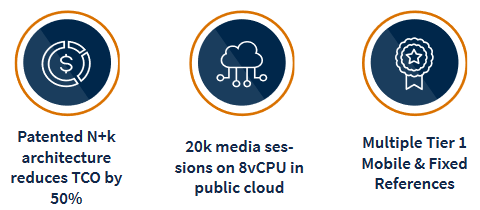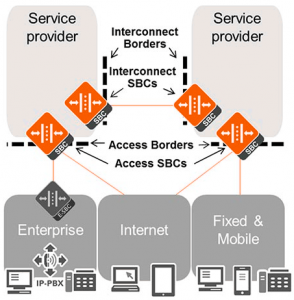Session Border Controller (SBC)
SBCs are inserted into the signaling and/or media paths between calling and called parties in a VoIP call, predominantly those using the Session Initiation Protocol (SIP), H.323, and MGCP call-signaling protocols.
The perimeter of any network is only as strong as its weakest link and must provide the secure basis required to ensure continuity and quality of your service offerings.
IPVision enables service providers to deliver trusted, first class interactive communications-voice, video and multimedia sessions-across IP network borders. Our solution of session border controllers satisfy critical security, service assurance and regulatory requirements in wireline, cable and wireless networks. Our deployments support multiple applications-from VoIP grunting to hosted enterprise and residential services; multiple protocols-SIP, H.323, MGCP/NCS and H.248; and multiple border points-interconnect, access network and data center with high availability


SBCs integrate signaling and media, performing session-aware call control functionalities. SBCs can be configured as B2BUA, B2BCA, B2BGK or just a simple SIP Proxy. They perform routing policies based on sessions or elements, traffic management assuring QoS levels. They also provide enhanced security measures to avoid attacks, flooding and malformed packets from reaching the core network.
Use Cases
• Mobile/VoLTE Access and Interconnect
• Fixed Access and Interconnect
• SIP Trunking
Security
• Static ACLs
• Dynamic blacklisting based on traffic
• Topology hiding
• SIP privacy support
• Zero Trust Security model
• Line rate DoS/DDoS protection
• FIPS 140-2 certified
• STIR/SHAKEN ready
• Fully integrated with MetaSphere QCall Signing and Verification Service
Media Interworking Features
• Transcoding: G.711, G.722, G.723.1, G.729A/B/AB, AMR-NB, AMR-WB, SILK, EVS, Opus, iLBC, T.38
• Available in software and with DSPs for high density transcoding
• In-band DTMF, DTMF in signalling and RFC2833 inter-working
• Transrating
• Comfort noise generation
• Fax/T.38 interworking
• RTCP generation
• RTP-SRTP interworking
• MSRP-MSRPS interworking
• NAT detection and traversal
• On-instance tone/announcement generation
• Video codec passthrough
SIP Interworking Features
• Powerful Message Manipulation Framework to manipulate and repair:
• SIP headers
• SIP bodies
• Diameter messages
• SIP/SIP-I interworking
• UPDATE/PRACK interworking
• Overlapping address spaces
• Number Portability
• Certified for Microsoft Teams
• eSRVCC and EATF function
• Registration monitoring
Network Integration
• Secure SIP load balancer available
• Deployment-wide admissions control
• IPSec tunnel/VPN support
• SIP over TLS v1.1/1.2/1.3
• IMS-AKA
• SIPREC call recording
• Lawful Interception
• APNS compliant
Cloud Native Design
The Perimeta software runs on any platform –public cloud, private cloud, virtualized or COTS hardware – and takes full advantage of today’s standard processors, offering outstanding performance. It can provide transcoding without GPUs or DSPs. And with its patented N + k redundancy model, it removes the need for passive backups that take up underlying platform resources, doubling the utilization of underlying hardware immediately.
Distributed Admissions Manager (DAM) and the Secure Distribution Engine (SDE) allow hundreds of Perimeta instances to act and be managed as a single logical SBC. This means that Perimeta SBCs act in unison to provide maximum security to the network and provide unparalleled centralized intelligence when distributing traffic and making admission decisions related to SLAs and capacity limits.
Service Assurance
• Configurable QoS/DSCP marking
• Billing in both XML and RF formats
• N + k media redundancy model
• In-built Geographic redundancy
• Always-on call tracing with SAS
Deployment Models
• Decomposed architecture supports independent scaling of signalling and media
• Optimised for Intel x86
• Same field hardened software available in:
• Public clouds (Azure, AWS)
• Private clouds (Openstack, VMWare)
• Common of the Shelf Hardware (e.g. DELL/HP)
• ATCA
• Containers
Management and Operations
• Deployment-wide declarative configuration
• Configuration via GUI, CLI, REST API
• Ready for fully automated deployment
• VNFM available
• Simple integration with 3rd party MANO
• Full automation solution with ServiceIQ automation enables scale to any size with no increase in opex
• Automatic scaling of signalling and media resources available
• CI/CD gitops management option
• Deployment-wide licensing
Monitoring
• SNMP V2/V3
• Log streaming to remote servers
• End-to-end visibility with Service Assurance Server
• Service IQ monitoring integration providing configurable dashboards for metrics, logs and alarms
• External monitoring feeds for analytics and probe substitution
